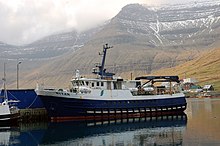Svínoy
| Svínoy | |
|---|---|
| Waters | Atlantic Ocean |
| Archipelago | Faroe Islands |
| Geographical location | 62 ° 15 '59 " N , 6 ° 21' 59" W |
| surface | 27.4 km² |
| Highest elevation | Havnartindur 586 m |
| Residents | 36 (September 1, 2016) 1.3 inhabitants / km² |
| main place | Svínoy |
| Map of Svinoy | |
Svínoy [ ˈsvʊinɔi ] / [ ˈsvʊinɪ ] (literally: Pig Island , Danish : Svinø ) is one of the 18 islands of the Faroe Islands and belongs to the geographical region of the six North Islands . At the same time it has the status of an "outer island" ( see Útoyggjar ).
General
The relatively flat island still has seven peaks. The only place on the island is the village of the same name Svínoy. Administratively, the place and island form part of the Faroese municipality Klaksvík ( Klaksvíkar kommuna ). The postal code of Svínoy is FO-765.
Together with the neighboring island of Fugloy , Svínoy forms the northeastern outpost of the 18 islands of the Faroe Islands. Due to the remote location, the population of Svínoy is declining significantly. In January 2016, a total of 26 people were still living on the island. Ten years earlier there were 55 residents. However, the population grew so rapidly in the course of 2016 that a total of 36 people called the island their home in September. The people find their livelihood in fishing and agriculture, as Svínoy is relatively fertile.
Svínoy probably owes the name Pig Island to pig farming , which was common in the Faroe Islands from the Viking Age to the Middle Ages .
history
Svínoy is one of the first settled islands in the Faroe Islands. The Viking chief Svínoyar-Bjarni mentioned in the Faroese saga is said to have been the first settler. The relatively flat land in the center of the island was easy to cultivate and cultivate. Depending on the weather, you could approach the place, which developed in the area of an isthmus between the two bays in the east and west of the island, from the east or the west. It is possible that there was a sacrificial site on the current site of the church in the Viking Age.
In 1860 there were 90 inhabitants on Svínoy, in 1911 there were 187 and in 1921 the population was 204 people. The school was built in 1888. The post office was opened on October 1, 1918. In place Svínoy lived in the 1960s, more than 200 people. Svínoy has been part of the Klaksvík Municipality since 2009.
Attractions
The Svínoy church dates from 1878 and is believed to be the grave of the great farmer Svínoyar-Bjarni , who lived here and is mentioned in the Faroese saga . In the anteroom of the church there is a large tombstone called Bjarnarsteinur , which was discovered during demolition work in 1828 and is said to date from the time of Svínoyar-Bjarni. Since Svínoy has a relatively large amount of flat land in contrast to most of the other islands of the Faroe Islands, easy-to-manage hikes are ideal, e.g. B. to the valley Yvir á Dal , in which peat used to be extracted.
Transport links
The transport company Strandfaraskip Landsins operates a regular ferry service with the passenger ferry Ritan from Hvannasund on Viðoy to Svínoy and Fugloy . The landing stage is about a kilometer west of the only village. A helicopter comes three times a week to take care of the islanders. There are calls from residents for an underwater tunnel, but it is questionable whether this will ever become a reality given the size of the population.
Infrastructure
There is a small village shop on the road from the village to the jetty. Svínoy also has a new marina and a modern cowshed. In 2005 the school had two students, but they have since moved to other islands. The teacher's apartment, which is currently uninhabited, serves as a community house.
There are no special accommodations for tourists, but camping is allowed in some places.
There are no cars on Svínoy, only a few commercial vehicles. You can easily explore the island on foot on the well-developed roads and paths.
Individual evidence
- ↑ Fólkatalsbroytingar skiftar á fødd, deyð, flutt og bygd, mánaðarliga (1985-2016) , hagstova.fo
- ↑ Størsti fólkavøkstur í einum ári síðani skjálvtarnar eftir stóra skrædlið fyrst í 1990-unum , hagstova.fo, October 13, 2016
- ↑ Wachter, Alexander: Discovering the Faroe Islands for yourself , p. 124f. Offenbach 2002.
- ↑ Kreuzenbeck, Ulrich: Färöer , p. 43. Düsseldorf 1983.
- ↑ Johnnessen, Steen Ulrik: Turen gar til Faeroerne , p. 60. Copenhagen 2000.
- ↑ Proctor, James: Faeroe Islands 158. Chalfont St Peter, Bucks, England., 2004
Web links
- Faroeislands.dk: Svínoy (in English. Info and photos)
- http://www.tjatsi.fo/show.php?sprog=9e60a69a8e7112e02f43bb4d2133e336&side=45bc5aa39657f00aa3c4b5b0ab3f6801 (link not available)
- Stamps.fo - Svínoy Postal History








